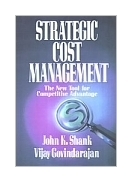|
||
• wydawnictwa polskie
• Zamów informacje o nowościach z wybranego tematu • kontakt
• Cookies na stronie |
STRATEGIC COST MANAGEMENTSHANK J., GOVINDARAJAN V.wydawnictwo: FREE PRESS , rok wydania 1993, wydanie Icena netto: As often reported in Business Week and Fortune, most large companies today concede that their cost systems are desperately obsolete. In this eagerly awaited book, John Shank and Vijay Govindarajan, nationally known experts on the strategic use of cost information, address head-on the fundamental concepts of management accounting that are in desperate need of change. The authors demonstrate how strategic cost management, the first analytic framework to relate meaningful accounting information to a firm's business strategy, is revolutionizing accounting - and overall business practices in leading firms. With numerous extended examples including Ciba-Geigy, Ford, Texas Instruments, and many more, the authors show how the three key tools of strategic cost management - value chain analysis, strategic positioning analysis, and cost driver analysis - provide a sustainable competitive advantage over firms whose cost systems are in disarray. With persuasive evidence, Shank and Govindarajan demonstrate the strategic power of value chain analysis, i.e., linking external value creating activities all the way from basic raw materials, to component suppliers, and through to the ultimate end-use product delivered to the consumers. Next, they examine how cost management and cost control must be differentiated depending on the strategic positioning chosen by the firm, be it cost leadership or product differentiation. Finally, the authors offer penetrating in-sights on cost driver analysis using such examples as Champion International and Motorola to describe the uses and limitations of activity-based costing, quality costing, and technology costing. Traditional cost analysis, the authors show, is limited to assessing the financial impact of managerial decision alternatives, with no consideration for strategic business objectives. In this indispensable guide, Shank and Govindarajan show how Strategic Cost Management (SCM) relates to a broader context, where strategic elements become far more conscious, explicit, and formal, and cost data is used to develop superior strategies en route to gaining sustainable competitive advantage. 271 pages Księgarnia nie działa. Nie odpowiadamy na pytania i nie realizujemy zamówien. Do odwolania !. |


